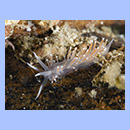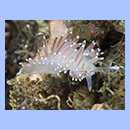- Kingdom: Animalia
- Phylum: Mollusca
- Class: Gastropoda
- Subclass: Heterobranchia
- Order: Nudibranchia
- Suborder: Dexiarchia
- Infraorder: Aeolidida
- Superfamily: Flabellinoidea
- Family: Coryphellidae
- Scientific name: Fjordia browni
- Norwegian: -
Characteristics:
The white pigmented cerata of F. browni are smooth or slightly wrinkled. The cerata are arranged in groups rather then rows. Around the tip of the cerata there is a white pigmented ring. F. browni lacks pink tint on the tentacles and warts on the rhinophores, features often seen on the similar C. verrucosa. Small individuals may be confused with M. gracilis, larger ones with some of the other Flabellinoidea species:
- M. gracilis does not exceed a length of 15 mm. The cerata is is usually arranged in two, but sometimes as many as five rows. The rhinophores are smooth.
- B. nobilis has rounded papillae on the rhinophores. The cerata are not split in groups.
- C. pellucida has red or orange, white tipped cerata. The rhinophores are wrinkled. There are white pigmentation on the tentacles.
- C. verrucosa has wrinkled rhinophores, usually with a white pigmented line. There may be a pink tint on the white-tipped cerata. Individuals with long cerata may be confused with many of the other Flabellina species.
Habitat:
It seems to prefer current exposed locations where the major food source, the hydroid T. indivisa, can be found.
Distribution:
F. browni has been registered across the northeastern Atlantic Ocean, including the North Sea, Norwegian Sea and the English Channel.


